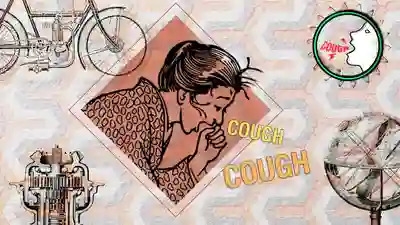Nonorganic Cough (Differential Diagnosis and Management)
Abstract
Nonorganic cough is a behavioral disorder characterized by a persistent, stereotyped cough in the absence of an organic cause. It is often associated with secondary gain and is most frequently seen in young females. This article outlines the clinical features, differential diagnosis, and recommended approach for diagnosis and management, emphasizing the importance of behavioral intervention over further medicalization.
Introduction
Chronic cough remains one of the more challenging presentations in outpatient medicine, particularly when organic causes are absent. Among these patients, a subset may exhibit what is best described as nonorganic cough—a condition driven by behavioral mechanisms and sustained by psychosocial reinforcement. This article reviews the clinical hallmarks, diagnostic differentiation, and practical management strategies for this often-overlooked condition.
Key Features of Nonorganic Cough
1. Stereotyped Pattern
Nonorganic cough typically follows a consistent and repetitive cadence throughout a clinical encounter. An example might be a pattern such as: “cough…cough…COUGH” …pause… “cough…cough…COUGH.” In contrast, sensory neuropathic cough (SNC), though sometimes stereotyped in sensation, often varies in pattern, duration, and severity. SNC episodes may be violent and less predictable.
2. Distractibility
The cough often diminishes or disappears entirely when the patient is distracted, deeply engaged in an activity, or asleep. It typically resumes upon reawakening or loss of distraction.
3. La Belle Indifférence
A hallmark psychological feature is a peculiar nonchalance about the disorder. Patients may appear surprisingly unaffected despite the significant social, academic, or functional impairment the cough has caused.
4. Secondary Gain
The cough may serve as a behavioral tool for avoiding stressors such as school, exams, or familial conflict. In some cases, it becomes central to family dynamics, commanding attention and concern.
Differential Diagnosis
Allergy
Consider if there is associated rhinorrhea, sneezing, or itchy eyes. An empirical antihistamine trial should yield improvement if this is the true cause.
Acid Reflux
Reflux-related cough often worsens nocturnally or early morning and may be accompanied by heartburn or “acid brash.” Trial of proton pump inhibitors or H2 blockers should offer relief if acid is contributory.
Asthma
A family history of asthma may be present, and supportive evidence can be obtained from pulmonary function tests or flow-volume loops. If truly the cause of the cough, a trial of asthma treatments such as albuterol or a steroid inhaler should result in improvement.
 A Real Contender to Put Aside: Sensory Neuropathic Cough
A Real Contender to Put Aside: Sensory Neuropathic Cough
Patients typically report a sudden, localized sensation (a tickle, dry patch, pinprick, or dripping sensation) that initiates the cough. There may be identifiable triggers—such as a loud laugh, breathing in cold air, change of position such as when lying down at night, touching a specific spot on the neck, or swallowing—that precipitate coughing episodes. A trial of neuralgia medications like amitriptyline or gabapentin often helps.
Management of Nonorganic Cough
Clinicians must recognize that nonorganic cough is often misunderstood or inadequately managed by those who rely solely on measurements and testing. Not every physician will be good at (or even be interested in being good at) managing this disorder.
A successful approach depends on strong observational and relational skills within an often-time-consuming visit. Even though the diagnosis is usually made on a prima facie basis, many patients have already undergone extensive evaluations to rule out the “usual suspects” mentioned above. Once nonorganic coughing is diagnosed, the basic steps of management include:
Affirm What the Disorder Is Not
Clearly dismiss/set aside the mis-diagnoses of infection, allergy, reflux, asthma, and other organic causes.
Explain the Nature of the Disorder—What it Is
Clarify that the problem is not with the cough mechanism itself but in the way coughing is being activated behaviorally. “The disorder is not in the mechanism but in the use of the mechanism.” And “We love helping patients with this very fixable problem.”
Establish Authority and Diagnostic Certainty
Validate the patient’s experience by noting, “You are in good company with many other patients with this condition.” It may also be helpful to add, “I am a physician who finds it easy to say ‘I don’t know,’ or ‘I am not sure, but this is a diagnosis I am certain of.’”
Set Expectations for Rapid Improvement
Inform the patient that this condition typically resolves quickly with appropriate behavioral intervention.
Emphasize Behavioral Training
Explain that the solution lies not in medication but in teaching or training. You might say, “We can help you find the solution within yourself.” If available, convey to the care of a speech pathologist experienced in nonorganic disorders, with a “not more than 2 visits” stipulation to avoid subtle formation of co-dependency between patient and speech pathologist.
Utilize Positive and Negative Practice
The clinician (or a speech pathologist) may mimic the patient’s cough and then pause, asking the patient to reproduce the pattern. This exercise can subtly reinforce the behavioral nature of the cough.
Educate Caregivers
Advise parents or significant others (including primary and other physicians) that further medicalization may obscure the true nature of the disorder and hinder progress. Their job is to ignore the behavior if it persists.
Follow Up and Reassure If the Coughing Continues More Than Two Weeks
Revisit the diagnosis, address any objections, and provide reassurance as necessary.
Reaffirm the Diagnosis if Needed
If the patient does not respond as expected or if family dynamics interfere, reaffirm the diagnosis, share examples of similar cases and how they resolved, and review the concepts of “primary loss” (the cough) and “secondary gain” (the benefits the “primary loss” provides, such as attention or avoidance of responsibilities).
How to Detect Nonorganic Cough in Children?
Here’s a real-life example of how psychogenic / behavioral coughing can manifest. Consider this question from distressed parents of a ten-year-old and Dr. Bastian’s response.
Dear Dr. Bastian,
Thank you so much for all your valuable information on sensory neuropathic cough via the internet. We have been at our wit’s end with our 10 year old daughter’s chronic cough. After numerous visits to the pediatrician, ENT, and pulmonologist as well as every medication imaginable, I think this condition is the cause of Anne’s* cough. I am an occupational therapist, and what you’re describing makes so much sense.
I must add that Anne (*name is changed) is extremely hypersensitive to pain and demonstrates some tactile sensitivities which I think may be contributory to her cough. My one question to you is: if she does have this condition would the cough cease while sleeping? Once Anne goes to sleep we do not hear any coughing. I wish we lived closer so we could have you examine her! Anyway, thank you again!
The Response:
First of all, I’m sorry to hear about your daughter’s trouble! While it’s impossible to know her exact diagnosis without a full evaluation, I can offer a few thoughts that may be helpful.
Sensory Neuropathic Cough (SNC) is not commonly diagnosed in children, especially younger ones. That doesn’t mean it can’t occur—I’m thinking of one patient who wasn’t diagnosed until age 72, but whose symptoms clearly began around age 9.
That said, a more common cause of persistent cough in children and teens is a functional or stress-related cough, often associated with recognizable “secondary gain,” in which the “cough” becomes a tool for the child to avoid things like school tests, gym class, or even to gain attention. Further comparison of the two different kinds of cough follows:
Functional/Nonorganic/Stress-related Cough:
- Often has a stereotyped pattern (e.g., cough-cough…COUGH!)
- May intensify with stressors that the child wants to avoid (tests, social pressures, etc.)
- The child may appear disconnected or unconcerned about the coughing or getting rid of it (aka “la belle indifference”)
- Often described as perfunctory or automatic
Sensory Neuropathic Cough (SNC):
- Usually initiated by a specific, localized sensation (tickle, dry patch, pinprick, etc.)
- Episodes vary in intensity—some brief, some aggressive or exhausting
- Bad episodes may cause tearing eyes, runny nose, etc.
- Patients are typically intensely focused on finding help
- Some patients cough at night, but many – even those with severe coughing during the day—don’t, so this isn’t a reliable distinguishing factor
What I mainly hope to do here is introduce two categories for your consideration: SNC, and psychogenic / behavioral (functional) cough. Both are real, and each has a distinct treatment pathway. If your daughter continues to struggle, it may be helpful to consult with a clinician familiar with both.
Conclusion
This comprehensive approach, relying on careful observation, clear communication, and behavioral intervention, is essential for effectively managing nonorganic cough.
References
- Vertigan AE, Theodoros DG, Gibson PG, Winkworth AL. Chronic refractory cough: Behavioural intervention and the need for a multidisciplinary approach. J Thorac Dis. 2017;9(3):725-730. https://doi.org/10.21037/jtd.2017.03.47
- Tarlo SM, Broder I. Psychogenic cough: Benefits of suggestion therapy. Can Med Assoc J. 1981;124(4):481-485. PMID: 7452634
- Stone J, Carson A, Sharpe M. Functional symptoms and signs in neurology: assessment and diagnosis. J Neurol Neurosurg Psychiatry. 2005;76(Suppl 1):i2-i12. https://doi.org/10.1136/jnnp.2004.061655
- Irwin RS, French CL, Chang AB, Altman KW; CHEST Expert Cough Panel. Classification of Cough as a Symptom in Adults and Management Algorithms: CHEST Guideline and Expert Panel Report. Chest. 2018 Jan;153(1):196-209. https://doi.org/10.1016/j.chest.2017.10.021
- Weinberger M, Lockshin B. When is cough functional, and how should it be treated? BMC Pediatr. 2017;17(1):122. https://doi.org/10.1186/s12887-017-0874-1
Share this article

Persistent Coughing as a Tool
Cough can have many causes—but one often-overlooked type is nonorganic cough. This refers to coughing that’s behavioral, often with identifiable secondary gain, rather than its being rooted in a physical disorder.
In this video, Dr. Bastian explains how to recognize nonorganic cough and outlines a practical, systematic approach to its diagnosis and management.